No one would ever mistake me for an athlete; nevertheless, I was intrigued by the Mio Alpha Heart Rate wrist watch from Mio Global because I’ve been attempting to get in better shape. Anything to help me prolong my life is a good thing, and in conjunction with my Fitbit and Aria devices, I figured I had the trifecta of gadget encouragement. I was interested to see if it would help me work harder at exercising.
The first thing I noticed about the watch was the quality build and robustness of the device. It is apparent that it was made to be used in a less than hospitable environment.
Specifications:
Clock: 12-hour
Timer: 9 hours 59 minutes 59 seconds
Max Readable Heart Rate: 220 BPM
Min Readable Heart Rate: 30 BPM
Operating Temp: 5°C to 45°C (41°F to 113°F)
Min Recommended Wrist Size: 145mm
Lens: Mineral Glass
Watchcase: PA+GF
Caseback: PC+CF
Caseback Contact Pads: SUS316
Strap: Silicon
Water Resistance: 30M
Battery: 170mAh Lithium Polymer
Expected Battery Life: Up to 5 Years
Magnets: Neodymium – iron – boron (NdFeB)
Radio Frequency/Protocol: 2.4 GHz ANT+ or Bluetooth® Smart Wireless Technology
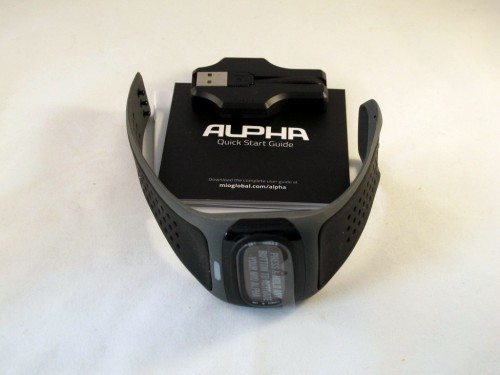 With the watch comes a quick start guide and the charger.
With the watch comes a quick start guide and the charger.
To charge, you’ll need a free USB port, or you can use one of your USB output chargers from another device.
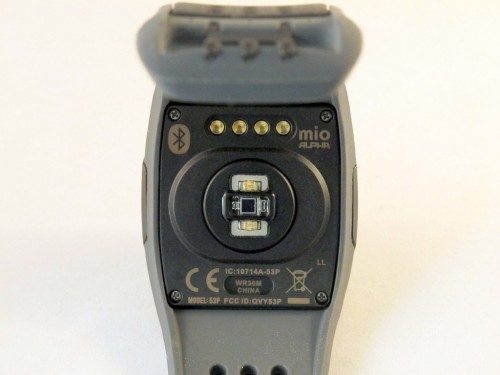 The back side of the watch is the real business end. Here the sensor contacts your arm to measure your pulse rate.
The back side of the watch is the real business end. Here the sensor contacts your arm to measure your pulse rate.
The objective of using the Mio is to exercise within a certain band of heart rates to realize the most benefits from the program. The Mio enables the wearer to set a lower and upper limit of heart rates in the device based upon your maximum heart rate (MHR). The MHR is a number that can be calculated based upon age, or provided by your doctor.
The above table is provided in the Mio manual for the upper and lower limits. These are set using the two buttons on the watch.
To test out the heart rate monitor capability, I found my MHR from the Mayo clinic website and input my upper and lower limits into the watch. I then hopped on the treadmill.
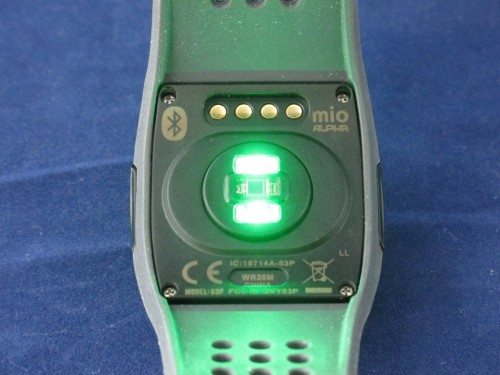 The device calculates your heart rate by sensing the blood flow in your arm. The back of the watch has two green LEDs with the sensor between them.
The device calculates your heart rate by sensing the blood flow in your arm. The back of the watch has two green LEDs with the sensor between them.
It is VERY important that the watch be attached snugly to your arm, above the wrist bone. It took me a bit to find the optimum placement, but once I found it, I had no problem sensing my heart rate.
As suggested in the manual, I did a couple of minutes on the treadmill before setting the device into exercise mode. This makes it easier for the watch to detect your pulse. After a few minutes, I discovered something about myself. I don’t have a normal heart rate for my age. I couldn’t get my rate anywhere near the calculated upper limit. After some research, I found that taking medication, such as beta blockers, will severely affect your beats per minute (BPM). After some adjustments to the limits, I decided to make my target 70 bpm, my upper limit 75, and my lower 65.
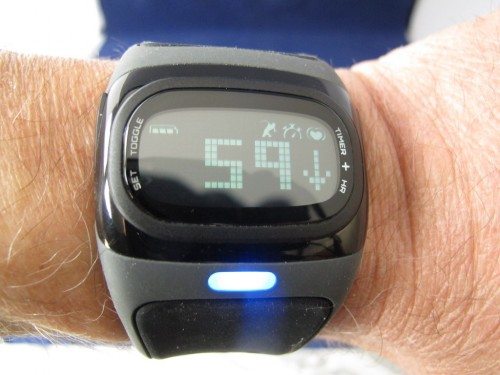 While exercising, the Mio will display the current heart rate. If it’s outside of the limits you set, it will inform you by a beep, an arrow on the display, and a change in color of the LED on the watch. Here it’s showing that I’m below my lower limit. The LED is blue for below, green for in the zone and red for above.
While exercising, the Mio will display the current heart rate. If it’s outside of the limits you set, it will inform you by a beep, an arrow on the display, and a change in color of the LED on the watch. Here it’s showing that I’m below my lower limit. The LED is blue for below, green for in the zone and red for above.
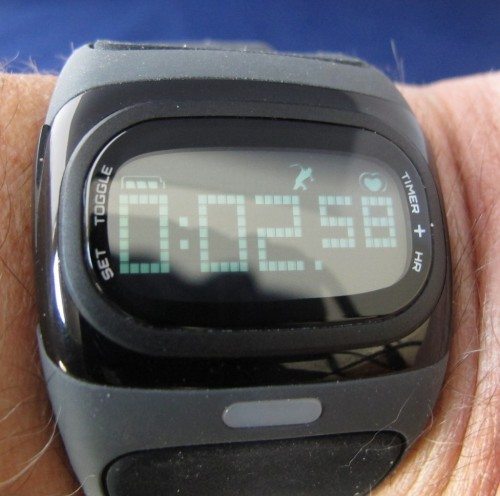 During your exercise, you can toggle the display to show you the elapsed time. You can also pause your run. At the end of your activities, the watch can display the time of your exercise, average heart rate for that period, and time in zone.
During your exercise, you can toggle the display to show you the elapsed time. You can also pause your run. At the end of your activities, the watch can display the time of your exercise, average heart rate for that period, and time in zone.
To get a better idea of the usefulness of the Mio, I enlisted the help of my son-in-law who’s into body building and spends a lot of time in the gym and does cardio exercises to burn calories. He set his target at 120 bpm as optimum for calorie burn. Using the Mio, he can keep the pace to stay within the target zone without having to stop and check his heart rate manually.
The Mio can be connected with some smart phones and apps using Bluetooth 4.0. I wasn’t able to test that feature because I don’t have a Bluetooth 4.0 device. It can also connect using an ANT+ dongle, which I also don’t have. I’ll take their word for it that it works.
Coincidentally, during the time I was testing the Mio, I had my annual physical and took the opportunity to compare the accuracy of the Mio to the doctor’s device. Impressively, it was spot on. Both the medical monitor and the Mio read 56 bpm.
The Mio Alpha watch is targeted at the high performance athlete, not someone like me, although I use it every time I’m on the treadmill or walking around the block. I time my exercise and keep track of my average heart rate. I’m not looking for any particular number, just trends.
For a runner or cyclist, the Mio Alpha Heart Rate Watch could help maximize your peak performance by helping you adjust your routine to stay within the “zone”. The Mio device performed as advertised and was easy to operate. The least useful function on the device is the timepiece feature. Although the Mio acts as a watch, it is very limited. It has no backlight and only displays the time ( no day and date ). I don’t consider this a negative, considering the purpose of the watch. In any case, one would probably only wear the watch when exercising.
INIU Mini Portable Charger, Small 45W PD Power Bank, 10000mAh USB C in&Out Fast Charging Pocket Size Battery Pack, Travel Essentials Powerbank for iPhone 17 16 15 14 Pro Air, Xiaomi, Samsung S24 etc
32% OffANDERY Car Phone Holder for Magsafe [78+LBS Strongest Suction & 2400gf Magnetic] 360° Adjustable Car Phone Mount, Phone Holders for Your Car for iPhone 17 Pro Max 16 15 14 13 12 Air Plus, Carbon Fiber
37% OffProduct Information
| Price: | $199 |
| Manufacturer: | Mio Global |
| Retailer: | Directly from Mio Global or from Amazon |
| Pros: |
|
| Cons: |
|

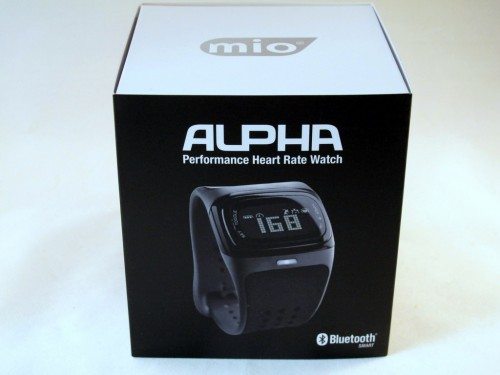
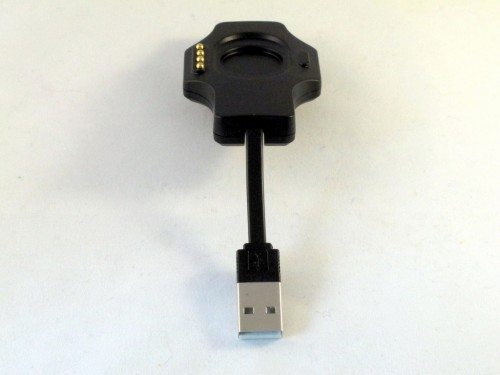


Gadgeteer Comment Policy - Please read before commenting
Good for you; keep it up (the heart rate that is).
Heart meds sure keep the rate low – the American College of Sports Medicine has a good resource section to help figure out how to accommodate beta-blockers, rate reducers and all.
I use a Suunto watch for about the same price. The chest band is probably less easy to use, but the computer connections and web support are enhancements.
Take care bro
Doctors look at the difference between your blood pressure readings during the
last two hours before retiring and your morning levels during the first two hours after rising to assess whether you have morning hypertension.
If you do the math (and thousands are already sold),
you could save literally multiple thousands of
dollars and add decades to your life by naturally treating high blood pressure.
Gall bladder disease is another disease that is affected by being overweight.
We reviewed the MIO Alpha as well (please google translate): http://ich-liebe-berge.ch/WordPress/2013/12/test-sportuhr-mio-alpha/